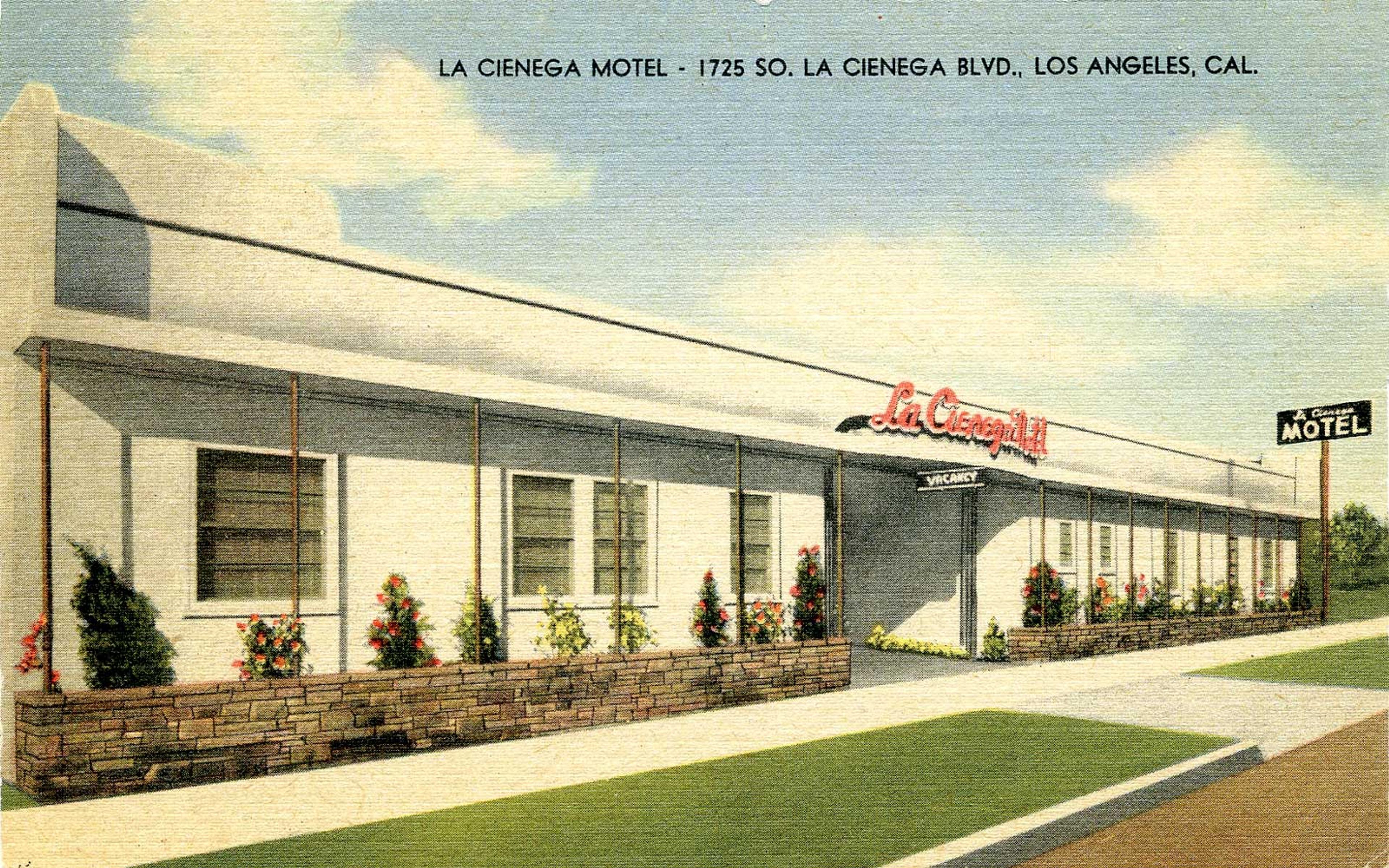It makes me sad, of course, when any 1946 motel is getting demolished. In this particular instance, I will admit, it would be more of a loss if the La Cienega Motel still looked like this:
But it does not. It has been remodeled, and looks like this.
Actually, until fairly recently (in 2015 owner Sanmukh Bhakta had Nextech Construction perform the above remodel, transforming the modest motel into the boujee La Cienega Inn) La Cienega Motel retained more of its original appointments, like the neon script sign above the auto entrance, and 1950s screen:
Exterior screen, left, and concrete block wall, right, were added in late 1959
But back to the neon script sign for a sec:
Fabricated by QRS Neon, installed October 1946. With the 2015 remodel we assume it’s at the bottom of a landfill, now.
Then of course there’s the giant rooftop sign, made by National Neon Co., installed in 1959 during the aforementioned screen-and-block façade remodel:
This is the La Cienega Motel I remember. This is the Los Angeles I moved to in 1993, taking full advantage of any establishment that retained vintage neon, including seedy motels, on occasion the scene of grotesque and improbable mischief, signage buzzing away outside. Ah, memories.
Seems like you youngsters today won’t have the magic and memory-making of a cheap motel. You’re too busy booking with Airbnb, or vacationing in virtual reality, or whatever it is you do.
In the meantime, 1940s motels shall disappear in favor of six-story housing developments. In this case, built by the sort-of-synagogue spiritual community IKAR:
While we’re on the subject of the doomed La Cienega Motel (sorry, La Cienega Inn) let’s check in on some of the other La Cienega Motels—
Park Cienega, 1777 So. La Cienega, J. Barron Hardy, 1953:
Hanging in there; they’ve made some changes to their sign, not the worst in the world, and actually repainted in a color closer to the original.
Rip Van Winkle Apartment Motel, 1479 S. La Cienega, F. O. Reyenga, 1947:
I know what you’re thinking—look at that sign; damn, what a tragically wasted opportunity to put a sleeping neon guy with a long white beard upon’t!
Neon which would have been torn out anyway, since the Rip Van Winkle has become the Motel Grand. Can is still there, though devoid of neon, albeit there was neon working fairly recently:
It even had one of those "Color TV by RCA" vacuform plastic signs which I love so much I may actually die
The Grand had a 2019 residential conversion by SoLa Impact; note the streetside doors have been removed. (Note too that the City installed a vintage street lamp! A Union Metal 1747 Pacific, with twin GE 18-B lanterns. Hubba Hubba!)
Capitol Motel, 1910 S. La Cienega, English & Ferraro, 1948:
Demolished by owner Abbas Tousi in 1995.
As was the 1947 Plantation Hotel (yes, they’re calling it a “hotel” but the text on the back of the card points out it’s a “Drive-In Hotel”) at 1930 S. La Cienega, built by the Lovett Brothers, demolished in 1996 by owner Hooman Allayee.
As long as I've got you here—if you dig old motels, you must have Motel California on your nightstand. It's wonderfully written and beautifully illustrated, just a joy to behold. And you can hand it to your kids when they ask "but what's a motel?" Get your copy at calmodbooks.com!
Eternal thanks to the people who posted pix on Flickr, and from whom I so shamelessly stole! At least I'm acknowledging that fact, and you: here, here, here, and here.
About Nathan Marsak
NATHAN MARSAK says: “I came to praise Los Angeles, not to bury her. And yet developers, City Hall and social reformers work in concert to effect wholesale demolition, removing the human scale of my town, tossing its charm into a landfill. The least I can do is memorialize in real time those places worth noting, as they slide inexorably into memory. In college I studied under Banham. I learned to love Los Angeles via Reyner’s teachings (and came to abjure Mike Davis and his lurid, fanciful, laughably-researched assertions). In grad school I focused on visionary urbanism and technological utopianism—so while some may find the premise of preserving communities so much ill-considered reactionary twaddle, at least I have a background in the other side. Anyway, I moved to Los Angeles, and began to document. I drove about shooting neon signs. I put endless miles across the Plains of Id on the old Packard as part of the 1947project; when Kim Cooper blogged about some bad lunch meat in Compton, I drove down to there to check on the scene of the crime (never via freeway—you can’t really learn Los Angeles unless you study her from the surface streets). But in short order one landmark after another disappeared. Few demolitions are as contentious or high profile as the Ambassador or Parker Center; rather, it is all the little houses and commercial buildings the social engineers are desperate to destroy in the name of the Greater Good. The fabric of our city is woven together by communities and neighborhoods who no longer have a say in their zoning or planning so it’s important to shine a light on these vanishing treasures, now, before the remarkable character of our city is wiped away like a stain from a countertop. (But Nathan, you say, it’s just this one house—no, it isn’t. Principiis obsta, finem respice.) And who knows, one might even be saved. Excelsior!””
Nathan’s blogs are: Bunker Hill Los Angeles, RIP Los Angeles & On Bunker Hill.
